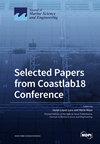周期性强制流控制的可调性和稳定性:数值研究
IF 2.8
3区 地球科学
Q1 ENGINEERING, MARINE
引用次数: 0
摘要
高效、稳定地应用周期性强制来减少阻力,有助于水下航行器长时间高速运行,并提高其能量利用效率。本研究考虑了通过环形槽受到周期性吹气或吸气的旋转体模型周围的流动控制。重点是在各种体变量(尺寸、自由流动速度、槽面积和吹气/吸气速度)和控制参数(归一化周期性强制振幅和相对槽尺寸)条件下控制流体的边界层结构、特性和阻力。车体变量对阻力减小率的影响各不相同,当 S 和 v 高于 S0 和 v0 时,表面压力会推动模型车辆。其中,随着 v 的增大,最低压力阻力为-26.4 N,总阻力的最大阻力减少率超过 135%。在雷诺数固定的情况下,控制参数值的增加会导致槽下游出现更大尺度的不稳定涡环;表面速度梯度减小,从而有效降低阻力。通过定量分析,建立了压力阻力周期性波动与机体变量相关的简单模型,并用于确定航行稳定性。本文章由计算机程序翻译,如有差异,请以英文原文为准。
Adjustability and Stability of Flow Control by Periodic Forcing: A Numerical Investigation
The efficient and stable application of periodic forcing for drag-reduction can help underwater vehicles operate at high speed for long durations and improve their energy-utilization efficiency. This study considers flow control around a body-of-revolution model subjected to periodic blowing or suction through annular slots. The focus is on the boundary-layer structure, properties, and drag of the control fluid under a wide range of body variables (size, free-flow velocity, slot area, and blowing/suction velocity) and control parameters (normalized periodic-forcing amplitude and relative slot sizes). Body variables differ in their effects on the drag-reduction rate, with the surface pressure pushing the model vehicle when S and v are higher than S0 and v0. In particular, the lowest pressure drag was −26.4 N with v increasing, and the maximum drag-reduction rate of total drag exceeded 135%. At a fixed Reynolds number, increasing the values of the control parameters leads to larger-scale unstable vortex rings downstream from the slots; the surface-velocity gradient is reduced, effectively lowering the drag. A simple model relating the periodic fluctuation of pressure drag to the body variables is developed through quantitative analysis and used to determine navigational stability.
求助全文
通过发布文献求助,成功后即可免费获取论文全文。
去求助
来源期刊

Journal of Marine Science and Engineering
Engineering-Ocean Engineering
CiteScore
4.40
自引率
20.70%
发文量
1640
审稿时长
18.09 days
期刊介绍:
Journal of Marine Science and Engineering (JMSE; ISSN 2077-1312) is an international, peer-reviewed open access journal which provides an advanced forum for studies related to marine science and engineering. It publishes reviews, research papers and communications. Our aim is to encourage scientists to publish their experimental and theoretical results in as much detail as possible. There is no restriction on the length of the papers. The full experimental details must be provided so that the results can be reproduced. Electronic files and software regarding the full details of the calculation or experimental procedure, if unable to be published in a normal way, can be deposited as supplementary electronic material.
 求助内容:
求助内容: 应助结果提醒方式:
应助结果提醒方式:


